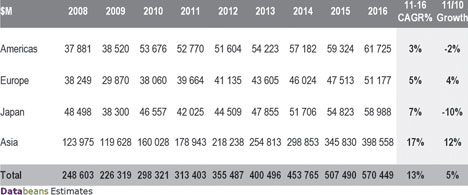
It has been a little over five months since the disastrous earthquake and tsunami that rocked Japan and its infrastructure, and the full impact of damage and subsequent recovery of the Japanese semiconductor market are finally being realised. Even though Japan will no longer be the world’s single largest semiconductor materials market, the industry’s importance to the country is unmatched.
Databeans predicts a 5% annual growth rate of worldwide semiconductor revenue for 2011 in their quarterly semiconductor market tracker. This growth is forecasted, even after all of the supply chain issues in Japan, because the Japanese recovery was so expedient. Companies have compensated for this supply chain disruption by securing additional output from other sources and making adjustments in the production mix. Luckily for the global semiconductor supply chain, the Japanese government has given semiconductor plants priority in their recovering economy and exempted them from power cuts. Almost all vendors have re-established their productions levels to levels before the earthquake.
One of the main disruptions to the supply chain arose from the lack of some raw materials. For example, hydrogen peroxide and 300 mm wafers were in short supply, delaying fabrication. Mitsubishi Gas Chemical Company, which supplies H2O2 to more than 60% of Japanese semiconductor suppliers, was severely crippled by the tsunami water. The chemical plant only reached normal shipment levels on 23 June. Concurrently the world’s largest 300 mm silicon wafer plant, Shin-Etsu Hantodai’s Shirakawa plant, only restarted operations on 1 July. Shin-Etsu Hantodai supplies 20% of the world’s 300 mm waters. With these large raw materials problems taken care of, the region’s recovery is well on its way.

Japan has proved its resilience to the world and after a short recovery, the region’s semiconductor growth will soon be positive. Databeans forecasts that in 2012, Japan will recover shipment levels to 112 billion units, which is 7% higher than 2011 levels. Revenue will take a hit in this region, dropping 10% in 2011 while companies in Japan regain the outsourced fabrication which was lost immediately after the quake. Companies such as Freescale Semiconductor and Fujitsu have just recently reached normal production levels and are working toward full recovery. Renesas, which was hit hardest by the 11 March quake, has pushed back their full recovery date until September. 2012 revenue for Japan is expected to grow by 6%.
All this data suggests that a swift and prosperous recovery for Japan is in the not so distant future. The biggest concern now is that the numerous aftershocks will further damage the region’s semiconductor industry. The US geological survey has reported around 100 aftershocks of a magnitude greater than 6. This raises the possibility of another earthquake and means that disruption to the industry is very possible. Many companies have continued or implemented crisis management teams so that business can return to normal as soon as possible after a disaster. What the world should learn from the earthquake is that proper precautions should always be taken for hazards in the business environment.
For more information visit www.databeans.net
© Technews Publishing (Pty) Ltd | All Rights Reserved